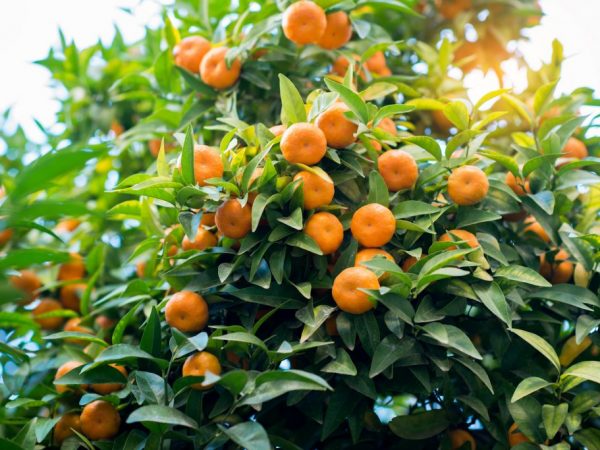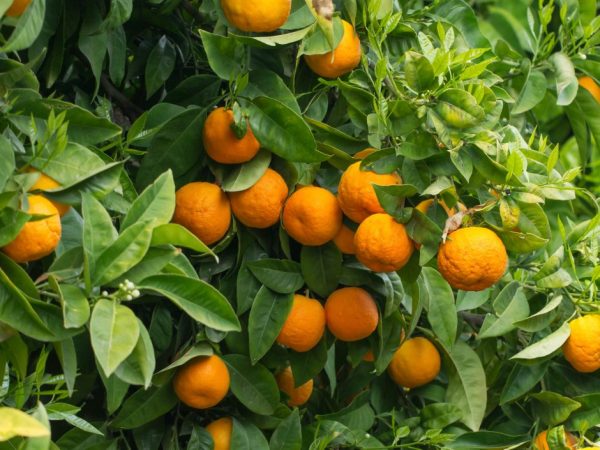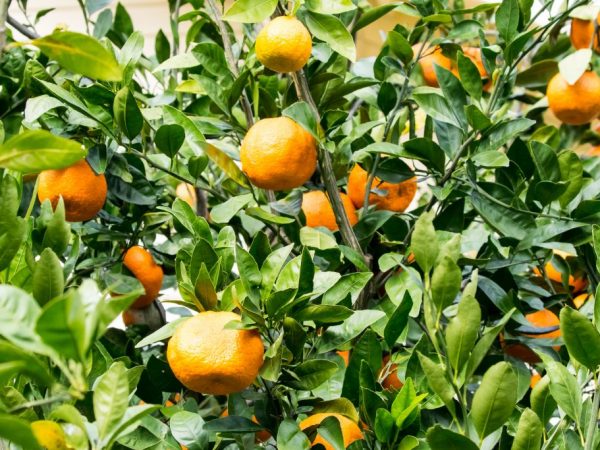Growing Unshiu Mandarin
There are many varietal varieties among tangerines, and one of them is the Unshiu tangerine.

Growing Unshiu Mandarin
Botanical description and range
According to the description, the Unshiu broadleaf tangerine is a woody evergreen shrub that grows in open ground up to 3 m, and when grown at home - no more than 1.5 m.It has a spreading crown, green foliage leathery to the touch. Leaves are oval with a slightly corrugated structure, narrowed at the ends.
The name of the citrus variety translates as “no seeds”.
The plant is in a state of activity for almost the entire life cycle, rest is mild and imperceptible. Unshiu inflorescences, as described, are white, formed by 5 petals. The main flowering period is in the spring (May). Subject to domestic agricultural practices, the plant bears fruit after 3-4 years from the moment of planting. Fruit taste is classic.
Area
The variety is originally from China. It was domesticated by the Japanese and further spread throughout the world countries. Today it is grown in the Caucasus, Uzbekistan, Western Europe and Israel. The variety is also found in Russia.
Microclimate for Unshiu
Unshiu mandarin is grown at home, creating a certain microclimate.
Temperature and illumination
The culture is provided with a constant temperature regime throughout the growing season, including:
- at the stage of bud formation, during flowering and in the process of fruit setting - 17 ° С-18 ° С,
- in the winter season, conditions with a temperature of 13 ° C-15 ° C will become comfortable.
The critical temperature indicators that Unshiu withstands without destructive consequences are 8 ° C-12 ° C.
Excessive heat leads to drying out of tangerine leaves, and if the temperature is not observed, the plant stops bearing fruit.
For full growth and development, citrus is provided with a sufficient amount of light. In winter, it is permissible to take Unshiu out to the insulated balcony in natural light conditions. From February to August, in the daytime, the plant is suitable for loose shading, which protects from direct sunlight, does not dry out the soil and at the same time provides light.
The plant is shaded from 11 to 15 hours.
The most suitable place for Unshiu at home is the southern or southeastern side of the room. In the southwest, conditions are too hot for citrus, and too cool in the north.
In winter, the plant is provided with additional illumination with fluorescent lamps of blue and white light, which are located at a distance of 0.2 m from the citrus crown. The required duration of daylight hours is 12 hours.
Humidity

The plant must be sprayed
If watering is moderate in winter, during spring and summer it is required to water Unshiu abundantly, however, this is done when the top layer of the substrate completely dries up to a depth of 5 cm. Usually, this state of the soil, ready for watering, occurs with an interval of 5-6 days.
In hot weather and elevated indoor temperatures, the plant is watered daily.
For Unshiu, humidity is important, which is regulated by spraying the plant, doing it several times every day in the summer, reducing once a day for the winter.
Unshiu transplant
A young Unshiu needs an annual transplant, especially when the citrus root system is completely enveloped in the earthen ball in the pot. A fruiting plant is transplanted every 3 years, limited in the intervals between procedures by changing the top layer of soil. Having reached the maximum size, indoor citrus is no longer transplanted, updating only the substrate, applying fertilizers.
A tangerine tree grown in a store in peat is not immediately transplanted after purchase, so as not to lose ovaries and fruits.
When transplanting, the previous pot container is changed to a new one, approximately 4 cm larger in size.A drainage system of broken brick or expanded clay with a height of about 5 cm is laid on the bottom.
The composition of the substrate for a young Unshiu should include:
- 2 parts of turf land,
- 1 part leafy soil
- 1 part three-year-old humus
- 1 part of coarse river sand or pebbles,
- 1 part vermiculite.
For an adult citrus, soil is made from the same components, taken in similar proportions, with the exception of sod land, which requires a little more - 3 parts.
Unshiu Fertilizer

Alternate mineral and organic fertilizers
The initial feeding of home-made Unshiu falls in the spring, 1 month after the plant is transplanted, for which mineral complexes and organics are suitable, which alternate with each other. Wherein:
- horse or cow manure diluted with water in a ratio of 1:10 is used as organic fertilizers,
- as a mineral supplement, they use ready-made complexes used in the cultivation of citrus fruits.
Unshiu does not tolerate a lack of potassium in the substrate, as indicated by yellowed and dried leaves at the edges. To compensate for the lack of an element, they use fertilizer complexes that do not have sulfur components of chlorine: carbonate or potassium sulfate.
Reproduction of Unshiu
Under the conditions of home cultivation, the reproduction of the Unshiu mandarin is carried out in one of the available ways:
- vaccinations,
- cuttings,
- layering,
- seeds.
A more suitable way of propagation of the Unshiu mandarin is considered to be cuttings. It gives the citrus the ability to bloom almost immediately after the formation of the root system.
The first color is immediately cut off to give the young seedling to gain strength and go into active growth.
It is also possible to grow citrus at home from seeds. When citrus multiplies, seed seeds taken from ripe tangerine are soaked in water for 3 days. When a white sprout appears, the seed is planted to a depth of 1 cm in a moderately moist substrate, consisting of a universal soil mixture and a small amount of vermiculite. The term for the emergence of the sprout is 3 weeks.
Other types of breeding are rarely used for Unshiu. Usually grafted on other varieties of citrus. Cutting is laborious, since the culture takes root within several months.
Conclusion
Unshiu tangerine grows not only in the wild, it is also grown at home. For a plant, it is required to create a certain microclimate in order to ensure its flowering and fruiting, to regularly apply fertilizers. Citrus is propagated in various ways, but the most suitable are cuttings and seeds.


